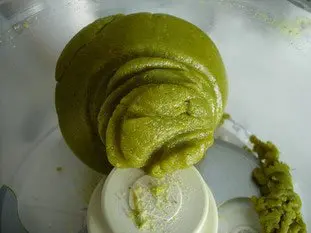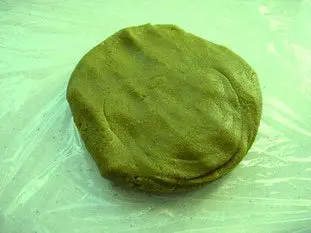Pistachio powder or paste
A recipe from cooking-ez.com October 13th 2010398 K 153.8
For 400 g, you will need:
- 1 200 g pistachios
- 2 200 g caster sugar
- 3 4 tablespoons water
- 4 1 egg white (optional)
- Total weight: 460 grams
Times:
| Preparation | Resting | Cooking | Start to finish |
|---|---|---|---|
| 20 min. | 15 min. | 20 min. | 50 min. |
Step by step recipe
| 1 | Preheat oven to 170°C (340°F). You can buy pistachios already blanched with their skins removed (the green ones on the left in the photo), or still in their skins (usually cheaper). |  |
| 2 | For this recipe the pistachios need to have the skins removed, so if you need to do this, plunge them for 2 minutes into boiling water. Drain, then slip off the skins, which should now be quite easy. |  |
| 3 | Spread out on a baking sheet, and put in the oven to dry roast for about 5 minutes. |  |
| 4 | Meanwhile heat 200 g caster sugar and 4 tablespoons water together in a small pan over high heat, and bring up to 120°C (250°F), using an electronic thermometer if possible. |  |
| 5 | When this temperature has been reached, tip the pistachios all at once into the pan. |  |
| 6 | Then stir with a wooden spatula. After a few seconds the mixture should become grainy. If this does not happen immediately it is because the sugar has not reached 120°C (250°F) yet. Don't worry, just keep stirring for a while longer until the change occurs. When the mixture has turned grainy (like in the photo), stop stirring, remove from the heat and leave to cool. |  |
| 7 | Tip the cooled contents of the pan into a blender or food processor. |  |
| 8 | Blend until it becomes evenly ground and green: pistachio powder. If you wish to use this powder for flavouring biscuits, a cake or a cream for example, use as it is. The powder is quite easy to incorporate. |  |
| 9 | If you want pistachio paste, to fill chocolates for example, it's useless to blend any longer as, unlike praline, it will not turn into a paste like this. All that's needed is the addition of a little egg-white (as for marzipan) to bind the powder. |  |
| 10 | The paste is best kept refrigerated, preferably spread into sort of flat cake, and wrapped in plastic film. Keep the powder at room temperature in an airtight jar. |  |
Remarks
You will note that this recipe, unlike many others, does not contain almonds, just pistachios and sugar.View this recipe : https://cooking-ez.com/base/recipe-pistachio-powder-paste.php
January 2nd 2026.

